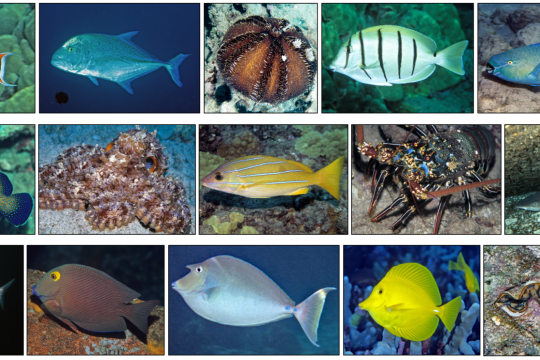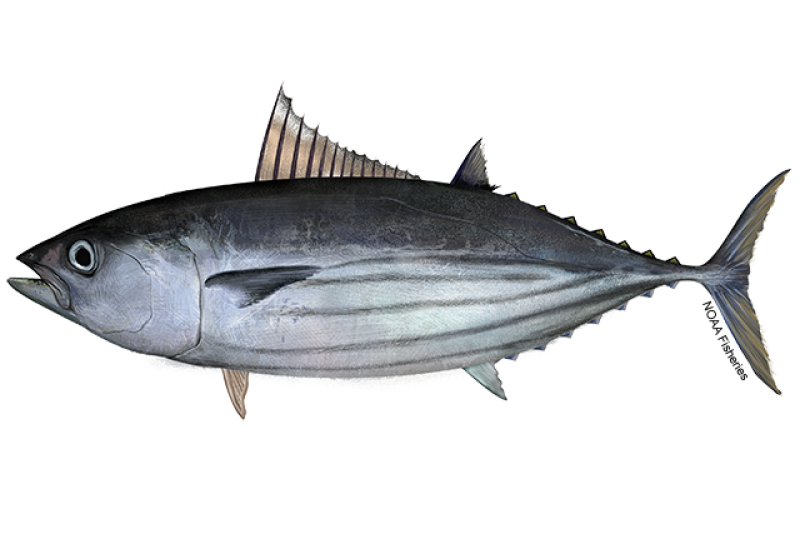 Wahoo fish. Credit: NOAA Fisheries
Wahoo fish. Credit: NOAA Fisheries
Wahoo fish. Credit: NOAA Fisheries
About the Species
 Wahoo fish. Credit: NOAA Fisheries
Wahoo fish. Credit: NOAA Fisheries
Wahoo fish. Credit: NOAA Fisheries
U.S. wild-caught Pacific wahoo is a smart seafood choice because it is sustainably managed and responsibly harvested under U.S. regulations.

Population
The stock has not been assessed. Although the population level is unknown, management measures are in place.

Fishing Rate
Overfishing status is unknown, but management measures are in place.

Habitat Impact
Fishing gear used to catch Pacific wahoo rarely contacts the ocean floor and has minimal impacts on habitat.

Bycatch
There is no directed fishery for Pacific wahoo. Regulations are in place to minimize bycatch in fisheries that incidentally catch this species.
Population Status
- The population status and fishing rate of Pacific wahoo are unknown because scientists do not formally assess wahoo populations.
- Scientists assume wahoo populations are stable because they are highly productive and widely distributed throughout the tropical/subtropical Pacific.
- Wahoo can handle relatively high fishing rates, but precautionary management seeks to maintain current harvest levels.
Appearance
- Wahoo are steel blue above and pale blue below.
- They’re covered with small scales and have a series of 25 to 30 irregular blackish-blue vertical bars on their sides.
- Wahoo have large mouths with strong, triangular, compressed, and finely serrated teeth.
- Their snouts are about as long as the rest of their heads.
Biology
- Wahoo grow fast, up to 8 feet and 158 pounds, though they are commonly between 3.3 and 5.4 feet long.
- Males are able to reproduce when they reach 2.8 feet in length, and females when they reach 3.3 feet. They’re usually about 1 year old at this stage.
- Wahoo spawn year-round in tropical waters and during the summer in higher latitudes, including Hawaii.
- Individual wahoo spawn multiple times throughout the spawning season. Females release millions of eggs per year to compensate for eggs that might not survive to adulthood.
- Wahoo mainly feed on fish, including frigate mackerel, butterfish, porcupine fish, and round herring. They compete with tuna for the same kind of food.
- Scientists have theorized that a wahoo is able to eat fish larger than itself by using its sharp teeth to render large prey into bite-size pieces.
- A number of predators feed on juvenile wahoo.
Where They Live
Range
- Wahoo are found in tropical and subtropical waters around the world.
- They are found in tropical waters year-round but are also found in higher latitudes during the summer.
Habitat
- Wahoo live near the surface and are frequently found alone or in small, loosely connected groups rather than in compact schools.
- They may also be found near banks, pinnacles, and natural debris drifting in the ocean.
Fishery Management
- NOAA Fisheries and the Western Pacific Fishery Management Council manage the Pacific wahoo fishery in the Western Pacific.
- Managed under the Fishery Ecosystem Plan for Pacific Pelagic Fisheries of the Western Pacific Region:
- Commercial fishermen must have permits and maintain logbooks.
- Longlines are prohibited in certain areas to protect endangered Hawaiian monk seals and reduce the potential for gear conflicts and localized stock depletion.
- Longline fishermen must carry a vessel monitoring system—a satellite transponder that provides real-time position updates and tracks vessel movements to enforce regulations.
- In Hawaii and American Samoa longline fishermen must also carry onboard observers when requested by NOAA Fisheries.
- Longline vessel owners and operators are required to attend annual protected species workshops.
- There are no management measures specific to wahoo because catch trends indicate that regulations are not necessary. However, management measures do apply to the troll and longline fisheries that incidentally harvest Pacific wahoo.
- NOAA Fisheries and the Pacific Coast Fishery Management Council manage fisheries that catch wahoo off the U.S. West Coast.
- Managed under the Fishery Management Plan for U.S. West Coast Fisheries for Highly Migratory Species:
- Wahoo is included in this plan as a monitored species. They are occasionally caught as part of another fishery’s non-target catch and are monitored on a consistent and routine basis.
Harvest
- Commercial fishery:
- U.S. commercial fisheries in the western and central Pacific harvest the majority of U.S.-caught wahoo.
- In 2023, commercial landings of Pacific wahoo from the Pacific Islands totaled 900,000 pounds and were valued at $2.7 million, according to the NOAA Fisheries commercial fishing landings database. The majority of the catch comes from Hawaii.
- Gear types, habitat impacts, and bycatch:
- There is no directed fishery for Pacific wahoo, but they may be incidentally harvested in troll and longline fisheries.
- Troll and longlines do not contact the ocean floor, so there are no impacts to habitat.
- U.S. pelagic longline fishermen who may incidentally catch wahoo are required to use specific tools and handling techniques to mitigate bycatch of turtles and marine mammals.
- Time-area closures also limit and prevent interactions between pelagic longline gear and non-target species.
- Onboard observers are required in some fisheries to record any interactions with sea turtles, seabirds, and marine mammals.
- Recreational fishery:
- In 2023, recreational landings of Pacific wahoo totaled 4.5 million pounds, according to the NOAA Fisheries recreational fishing landings database.
Scientific Classification
- Wahoo are found in tropical and subtropical waters around the world.
- They are found in tropical waters year-round but are also found in higher latitudes during the summer.
- Wahoo live near the surface and are frequently found alone or in small, loosely connected groups rather than in compact schools.
- They may also be found near banks, pinnacles, and natural debris drifting in the ocean.
Fishery Management
- NOAA Fisheries and the Western Pacific Fishery Management Council manage the Pacific wahoo fishery in the Western Pacific.
- Managed under the Fishery Ecosystem Plan for Pacific Pelagic Fisheries of the Western Pacific Region:
- Commercial fishermen must have permits and maintain logbooks.
- Longlines are prohibited in certain areas to protect endangered Hawaiian monk seals and reduce the potential for gear conflicts and localized stock depletion.
- Longline fishermen must carry a vessel monitoring system—a satellite transponder that provides real-time position updates and tracks vessel movements to enforce regulations.
- In Hawaii and American Samoa longline fishermen must also carry onboard observers when requested by NOAA Fisheries.
- Longline vessel owners and operators are required to attend annual protected species workshops.
- There are no management measures specific to wahoo because catch trends indicate that regulations are not necessary. However, management measures do apply to the troll and longline fisheries that incidentally harvest Pacific wahoo.
- NOAA Fisheries and the Pacific Coast Fishery Management Council manage fisheries that catch wahoo off the U.S. West Coast.
- Managed under the Fishery Management Plan for U.S. West Coast Fisheries for Highly Migratory Species:
- Wahoo is included in this plan as a monitored species. They are occasionally caught as part of another fishery’s non-target catch and are monitored on a consistent and routine basis.
Harvest
- Commercial fishery:
- U.S. commercial fisheries in the western and central Pacific harvest the majority of U.S.-caught wahoo.
- In 2023, commercial landings of Pacific wahoo from the Pacific Islands totaled 900,000 pounds and were valued at $2.7 million, according to the NOAA Fisheries commercial fishing landings database. The majority of the catch comes from Hawaii.
- Gear types, habitat impacts, and bycatch:
- There is no directed fishery for Pacific wahoo, but they may be incidentally harvested in troll and longline fisheries.
- Troll and longlines do not contact the ocean floor, so there are no impacts to habitat.
- U.S. pelagic longline fishermen who may incidentally catch wahoo are required to use specific tools and handling techniques to mitigate bycatch of turtles and marine mammals.
- Time-area closures also limit and prevent interactions between pelagic longline gear and non-target species.
- Onboard observers are required in some fisheries to record any interactions with sea turtles, seabirds, and marine mammals.
- Recreational fishery:
- In 2023, recreational landings of Pacific wahoo totaled 4.5 million pounds, according to the NOAA Fisheries recreational fishing landings database.
Scientific Classification
| Kingdom | Animalia | Phylum | Chordata | Class | Actinopterygii | Order | Scombriformes | Family | Scombridae | Genus | Acanthocybium | Species | solandri |
|---|
Last updated by NOAA Fisheries on 05/28/2025
Featured News
 Fifteen of the 83 species included in the Pacific Islands vulnerability assessment. From left to right: Acanthurus achilles, Caranx melampygus, Tripneustes gratilla, Acanthurus triostegus, Scarus rubroviolaceus, Cephalopholis argus, Octopus cyanea, Lutjanus kasmira, Panulirus penicillatus, Triaenodon obesus, Selar crumenophthalmus, Ctenochaetus strigosus, Naso unicornis, Zebrasoma flavescens, Tridacna maxima. Photo credit: Bruce Mundy.
Fifteen of the 83 species included in the Pacific Islands vulnerability assessment. From left to right: Acanthurus achilles, Caranx melampygus, Tripneustes gratilla, Acanthurus triostegus, Scarus rubroviolaceus, Cephalopholis argus, Octopus cyanea, Lutjanus kasmira, Panulirus penicillatus, Triaenodon obesus, Selar crumenophthalmus, Ctenochaetus strigosus, Naso unicornis, Zebrasoma flavescens, Tridacna maxima. Photo credit: Bruce Mundy.
 Jonah crab on toast. Credit: NOAA Fisheries/Heather Soulen.
Jonah crab on toast. Credit: NOAA Fisheries/Heather Soulen.
Seafood Lovers Showed Us Their Seafood

Seafood Facts

Is Pacific Wahoo Sustainable?
U.S. wild-caught Pacific wahoo is a smart seafood choice because it is sustainably managed and responsibly harvested under U.S. regulations.
Availability
Year-round, with peaks during summer and fall.
Source
U.S. wild-caught from Hawaii, U.S. Pacific Island territories, and on the high seas.
Taste
Lean and mild.
Texture
Firm with a large, circular flake.
Color
Raw meat is pale pink. It turns white when cooked.
Health Benefits
Wahoo is an excellent source of low-fat protein.
Nutrition Facts
Servings: 1; Serving Weight: 100 g (raw); Calories: 167; Protein: 19.32 g; Total Fat: 9.36 g; Total Saturated Fatty Acids: 2.444 g; Carbohydrate: 0 g; Total Sugars: 0 g; Total Dietary Fiber: 0 g; Cholesterol: 64 mg; Selenium: 39 mcg; Sodium: 78 mgMore Information
Wahoo (Ono) Recipes
Need cooking inspiration to incorporate wahoo (ono) into your rotation? Browse these recipes for Bahama-style wahoo, pan-roasted wahoo, and more!

Last updated by NOAA Fisheries on 05/28/2025
Seafood News
 Celebrate Culinary Arts Month with a sustainable seafood recipe for every month of the year.
Celebrate Culinary Arts Month with a sustainable seafood recipe for every month of the year.
What Your Birth Month Says About Your Next Seafood Recipe
 Fresh-caught taʻape on ice. Credit: Conservation International Hawaiʻi.
Fresh-caught taʻape on ice. Credit: Conservation International Hawaiʻi.
Reducing Waste and Feeding Communities in Hawaiʻi with a Whole Fish Approach
 Chef Tyler Hadfield’s Curried Skate Wings with Tomato-Masala Chutney
Chef Tyler Hadfield’s Curried Skate Wings with Tomato-Masala Chutney
Ring In the New Year With These Crowd-Favorite Seafood Recipes
 NOAA Fisheries, in collaboration with Blue Ocean Mariculture, is conducting a multi-year pilot study to evaluate observational methods and tools for studying Hawaiian monk seal behavior. Courtesy of Blue Ocean Mariculture
NOAA Fisheries, in collaboration with Blue Ocean Mariculture, is conducting a multi-year pilot study to evaluate observational methods and tools for studying Hawaiian monk seal behavior. Courtesy of Blue Ocean Mariculture
AI Meets Aquaculture to Study Hawaiian Monk Seal Interactions With Net Pens
Data & Maps
American Samoa Longline Logbook Reports 2023
Logbook summary reports for the 2023 calendar year.
American Samoa Longline Logbook Reports 2022
Logbook summary reports for the 2022 calendar year.
Hawaii and California Longline Logbook Reports 2022
Logbook summary reports for the 2022 calendar year.
Hawaii and California Longline Logbook Reports 2021
Logbook summary reports for the 2021 calendar year.
Research
Relative Impacts of Simultaneous Stressors on a Pelagic Marine Ecosystem
Model suggests that due to climate change, a decline in the yield of Hawaii's longline fishery may…
Last updated by NOAA Fisheries on 05/28/2025




